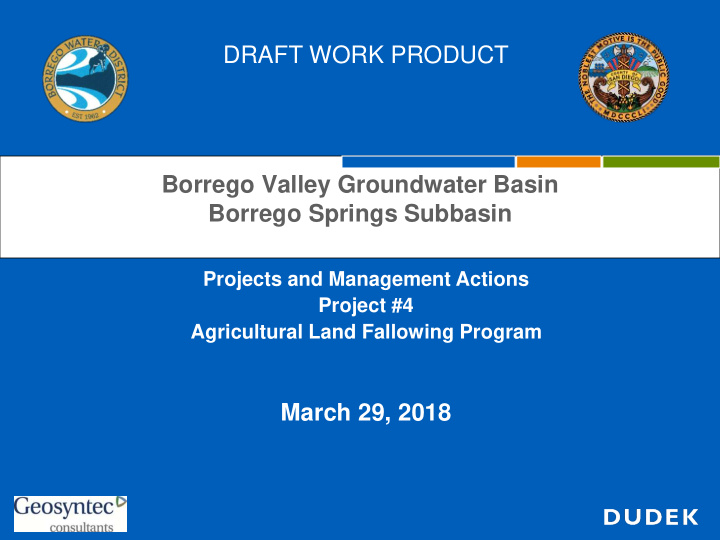



DRAFT WORK PRODUCT Borrego Valley Groundwater Basin Borrego Springs Subbasin Projects and Management Actions Project #4 Agricultural Land Fallowing Program March 29, 2018
Agricultural Land Fallowing Program Fallowing: Conversion of high water use irrigated agricultural to low water use, open space/public lands or development Currently there is approximately 3,373 acres of active agricultural land Permanent fallowing of agriculture is required to achieve sustainability
Recent and Historical Fallowing Approximately 2,483 acres historically fallowed Approximately 560 acres recently fallowed as part of the water credits program Currently approximately 3,373 acres of active agriculture Fallowing has been occurring for decades DRAFT WORK PRODUCT; Historical Fallowing based on USGS 1959 land use shapefile (USGS 2015)
Conditions to Determine Fallowing Approach Risk of airborne emissions varies by site condition • Soil texture • Landscape position • Ground cover • Wind • Historical use WORKING DRAFT PRODUCT; Wind rose diagram from meteoblue station located 33.26N 116.38W (To be updated with additional data as part of future fallowing plan)
Site Stabilization Site Stabilization: Short-term/temporary approach that stabilizes land surface and avoids blight of dead tree stands. • Removing trees and • Cutting and chipping applying a bonded fiber orchard trees and matrix to stabilize soils spreading over the surface Cost estimate: $10,000- Cost estimate: $1,000- $15,000 per acre 1 $10,000 per acre 1 1. Preliminary cost estimates based fallowed land in Borrego Springs and similar projects.
Tree Removal Methods Mulching: Cutting and chipping trees to spread across site for soil stabilization • Cover soil surface and reduces dust emissions • Acts as mulch and conserves water • Reduces weed growth 1. Mulching best management practice (BMP) will be developed to standardize requirements.
Desert Restoration Challenges Desert Environment Highly Disturbed Agricultural Restoration Lands Restoration • Highly unpredictable • Soil compaction weather • Hydrological modifications • Low precipitation • Weed infestation • Excessive heat and • Soil quality degradation drought • Potential Pesticide • Remote site locations contamination
Active and Passive Restoration Active Restoration Passive Restoration • • Full and relatively rapid Gradual conversion to natural conversion to natural habitat habitat (State parks, open space trails, • Includes: etc.) Tree removal • Includes: Site contouring Horizontal/vertical mulch Soil decompaction Supplemental seeding and/or Native seed collection and planting application Maintenance and monitoring • Con: Longer timeframe (many Remedial actions and goals years to decades) in a desert • Cons: Labor intensive and environment • expensive Pro: Less labor intensive and • Pro: Shorter timeframe (as little as expensive than active restoration five years) • Cost estimate: $5,000-$25,000 per • Cost estimate: $10,000-$50,000 per acre. acre
Additional Fallowing Considerations Preliminary Environmental Site Assessment Pesticide Sampling of Soils (screening level) Groundwater quality sampling of wells (nitrate) Removal of infrastructure and equipment Removal of Well Equipment Proper Abandonment of Wells
Recommendation Approach to fallowing will be site specific and will consider the following: • Future land use (low water use Ag, open space, public land, development, etc.) • Probability of restoration success • Proximity to natural open space • Potential environmental conditions (e.g. airborne emissions)
Recommend
More recommend